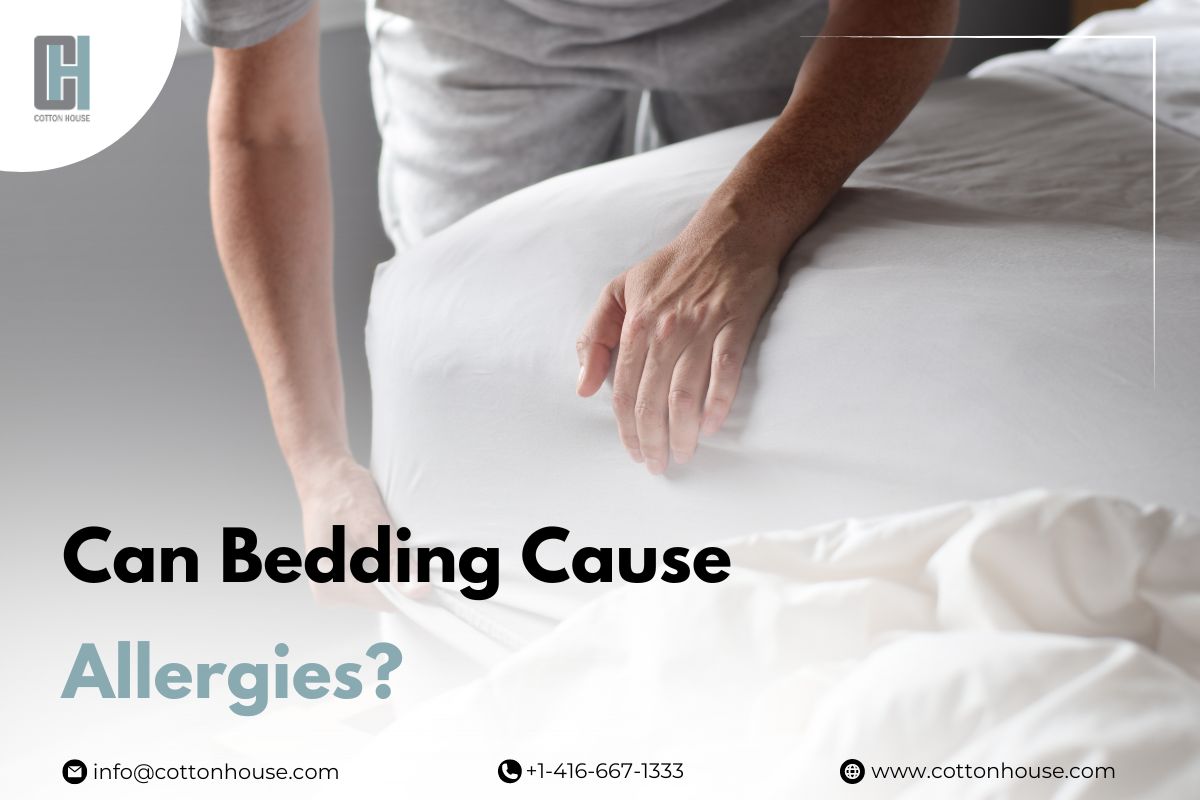
Have you ever woken up with a runny nose, itchy eyes, or relentless sneezing? These frustrating symptoms could be tied to an unexpected source: your bedding. Can bedding cause allergies? Absolutely. Many of us spend a significant portion of our day nestled in our beds, unaware that the very fabrics meant to comfort us might be harboring allergens.
Allergies to bedding are not just about the dust mites that thrive in the cozy corners of our pillows and mattresses; they can also arise from the materials themselves. From the types of fibers to the chemicals used in processing, several factors can turn a peaceful slumber into a night of discomfort. Understanding bedding allergy symptoms can help you identify and mitigate these unseen threats.
But why bedding cause allergies in the first place? It often comes down to the microscopic environment within our sheets and the allergens they accumulate over time. Let’s get deeper into how your bedding could be affecting your health and explore solutions to ensure your bedroom remains a sanctuary for rest, not reactions.
Why Bedding Cause Allergies?
Bedding can significantly contribute to allergies primarily due to the presence of dust mites, which thrive in the warm, moist environment provided by beds. These microscopic creatures feed on the skin cells humans shed, and their droppings can trigger allergic reactions like sneezing, nasal congestion, and itching(
To combat these allergens, investing in anti-allergy bedding is essential. These products are designed with tightly woven fabrics that prevent allergens from penetrating the surface, providing a barrier against dust mites, pet dander, and other common allergens. Additionally, dust mite resistance can be enhanced by choosing bedding materials that are less hospitable to these pests, such as those that can be frequently washed in hot water to kill mites and remove allergens.
For those wondering how to avoid bedding allergies effectively, regular washing of your bedding in hot water, using hypoallergenic covers for mattresses and pillows, and maintaining a low humidity level in the bedroom are practical steps. These measures help minimize the presence of dust mites and other allergens that can cause discomfort and disrupt sleep.
By understanding what causes bedding allergies and taking proactive measures to counter them, you can create a healthier, more comfortable sleeping environment.
Benefits of Anti-Allergy Bedding:
| Feature | Benefits | Recommended Products |
| Hypoallergenic Material | Reduces the presence of dust mites and pet dander | Bamboo, Microfiber |
| Dust Mite Resistance | Prevents dust mites from accumulating and reduces allergen exposure | Dust mite-proof covers |
| Easy to Wash | Allows for frequent washing to remove allergens and maintain cleanliness | Cotton covers |
| Moisture-wicking | Keeps the bedding dry and less hospitable to allergens | Wool, Specialty blends |
| Chemical-free | Avoids irritation from harsh chemicals used in traditional bedding processing | Organic cotton, Tencel |
How Bedding Can Trigger Allergies?
Bedding is a common yet often overlooked culprit in causing allergic reactions. Can bedding cause allergies? Yes, indeed. Various elements of bedding materials can lead to significant discomfort for individuals sensitive to allergens. Here’s how:
Dust Mites: One of the primary reasons why bedding causes allergies is due to dust mites. These tiny creatures thrive in the warm and humid environment that beds typically provide. They feed on the skin cells humans shed naturally during sleep. The waste produced by dust mites is highly allergenic and can lead to bedding allergy symptoms like sneezing, runny nose, itchy eyes, and even asthma attacks.
Fabric and Chemicals: Another factor why bedding causes allergies is the materials used in bedding. Synthetic fabrics, along with the chemicals used in manufacturing and treating these fabrics, can trigger allergic reactions. People with sensitive skin or chemical sensitivities may react to these substances, leading to skin irritation and respiratory issues.
Mold and Fungi: Beds can also harbor mold and fungi, especially if the bedding is not dried properly or if the environment is inherently damp. These allergens can cause respiratory symptoms and skin rashes.
To mitigate these issues, anti-allergy bedding can be a significant relief. Such bedding is designed to be hypoallergenic, resisting dust mites, mold growth, and minimizing the impact of harmful chemicals. Investing in anti-allergy bedding can help reduce exposure to allergens and improve sleep quality by alleviating allergy symptoms.
Can bedding cause allergies? Absolutely, but with the right precautions and products like anti-allergy bedding, it’s possible to create a healthier sleep environment.
Types of Allergies Caused by Bedding
| Type of Allergy | Allergen Source | Common Symptoms | Potential Solutions |
| Dust Mite Allergy | Waste from dust mites | Sneezing, runny nose, itchy eyes, asthma attacks | Use dust mite-proof covers, wash bedding in hot water |
| Chemical Sensitivity | Chemicals in synthetic fabrics | Skin rashes, respiratory issues | Choose organic or natural fiber bedding, avoid treated fabrics |
| Mold Allergy | Mold spores in damp bedding | Coughing, wheezing, nasal congestion | Ensure bedding is dry, use dehumidifiers, wash bedding regularly |
| Pet Dander Allergy | Pet dander on bedding | Itchy skin, sneezing, red eyes | Keep pets off the bed, use hypoallergenic bedding |
| Pollen Allergy | Pollen transferred to bedding | Similar to hay fever symptoms | Shower before bed during pollen season, keep windows closed |
Each type of allergy requires a slightly different approach to management, focusing on reducing exposure to the specific allergen and using bedding materials that help mitigate these triggers.
Choosing Allergy-Friendly Bedding:
When selecting bedding to minimize allergic reactions, understanding why bedding causes allergies is crucial. Can bedding cause allergies? Yes, through a variety of allergens present in typical bedroom environments. To combat bedding allergy symptoms, opting for anti-allergy bedding is recommended. Here are the best types of bedding materials for those prone to allergies:
Hypoallergenic Synthetic Fibers: Polyester and other synthetic fibers often resist allergens better than natural alternatives because they are less hospitable to dust mites and mold. They are also easier to wash frequently at high temperatures, which can kill mites and remove allergens.
Organic Cotton: Unbleached and not treated with chemicals, organic cotton is an excellent option for those with chemical sensitivities. It’s breathable, which helps prevent the buildup of moisture and reduces the growth of mold and dust mites.
Bamboo: Bamboo bedding is becoming increasingly popular due to its natural anti-microbial properties. It resists allergens and bacteria, making it a good choice for allergy sufferers. Additionally, bamboo is moisture-wicking, which helps keep the bedding dry and less likely to harbor mold and dust mites.
Silk: Silk contains natural proteins that are inherently mold and mite resistant. While silk can be an expensive option, it is beneficial for those with allergies due to its natural properties and smooth texture, which is less likely to irritate sensitive skin.
Microfiber: Microfiber is tightly woven, which makes it difficult for allergens to penetrate. This type of bedding is an excellent barrier against dust mites and other allergens, and it’s typically more affordable than some natural fiber options.
When considering why bedding causes allergies, the choice of materials can make a significant difference. Using anti-allergy bedding and hypoallergenic materials can greatly reduce the presence of allergens, leading to a better night’s sleep free from allergy symptoms. Regular washing and care, along with the right choice of materials, are key in managing allergies related to bedding.
Maintenance Tips to Reduce Allergy Triggers:
Maintaining a clean and allergy-friendly bedroom environment is crucial for minimizing allergy triggers from bedding. Here are some effective tips to help you keep allergens at bay:
- Wash sheets, pillowcases, and blankets at least once a week in hot water (at least 130°F) to kill dust mites and remove allergens. Using a hypoallergenic laundry detergent can also help reduce potential skin irritations.
- Encase mattresses, pillows, and duvets in dust mite-proof covers. These covers are made from tightly woven fabric that prevents dust mites and their waste from penetrating through to the areas where you breathe.
- Use a vacuum cleaner equipped with a HEPA filter to vacuum the bedroom floors and any upholstered furniture regularly. This helps remove dust and allergens that have settled on surfaces.
- Maintain the humidity in your bedroom below 50% to inhibit the growth of mold and dust mites. Using a dehumidifier or air conditioner can help manage humidity levels effectively.
- Let your bedding air out during the day to reduce moisture buildup, which attracts dust mites. If possible, expose your bedding to direct sunlight, which can help kill mites and mold.
- If possible, remove carpeting from the bedroom as carpets can trap and hold allergens. Opt for hardwood, tile, or another hard surface flooring that is easier to keep free of allergens.
- Pet dander is a common allergen; keeping pets out of your sleeping area can significantly reduce exposure to this trigger.
- Pillows and mattresses can accumulate allergens over time. Consider replacing pillows every year or two and have a protective cover over the mattress which should be cleaned regularly.
Conclusion:
Can bedding cause allergies? Yes, it absolutely can, and understanding why bedding causes allergies is crucial for anyone looking to improve their sleep quality and overall health. From the tiny dust mites that find their homes in our sheets to the synthetic chemicals that can irritate our skin and airways, there are multiple reasons why our bedding can be the source of discomfort. Investing in anti-allergy bedding and adopting rigorous maintenance routines can be transformative.
These materials and practices not only minimize the presence of allergens but also enhance the overall environment of our bedrooms, making them sanctuaries of health and relaxation rather than sources of sneezes and sniffles. By choosing the right bedding and following effective cleaning strategies, we can significantly reduce allergy symptoms and enjoy a cleaner, healthier sleeping space.
FAQS
What are the best types of hypoallergenic bedding materials?
Bamboo, silk, organic cotton, and microfiber are among the best types of hypoallergenic bedding materials, offering natural resistance to dust mites and allergens.
How often should I wash my bedding to keep allergies at bay?
To minimize allergy triggers, it’s recommended to wash your bedding once a week in hot water, ideally at temperatures that exceed 130°F (55°C) to effectively kill dust mites and remove allergens.
Can memory foam pillows reduce allergic reactions?
Yes, memory foam pillows can reduce allergic reactions as they are inherently hypoallergenic, resisting dust mites and other potential allergens more effectively than traditional pillow materials.
Are there specific bedding brands that are better for allergy sufferers?
Yes, there are bedding options specifically designed for allergy sufferers that focus on hypoallergenic materials and dust mite resistance. These products typically use tightly woven fabrics and natural fibers that help prevent allergens from accumulating, offering a better sleep environment for those sensitive to common irritants.



